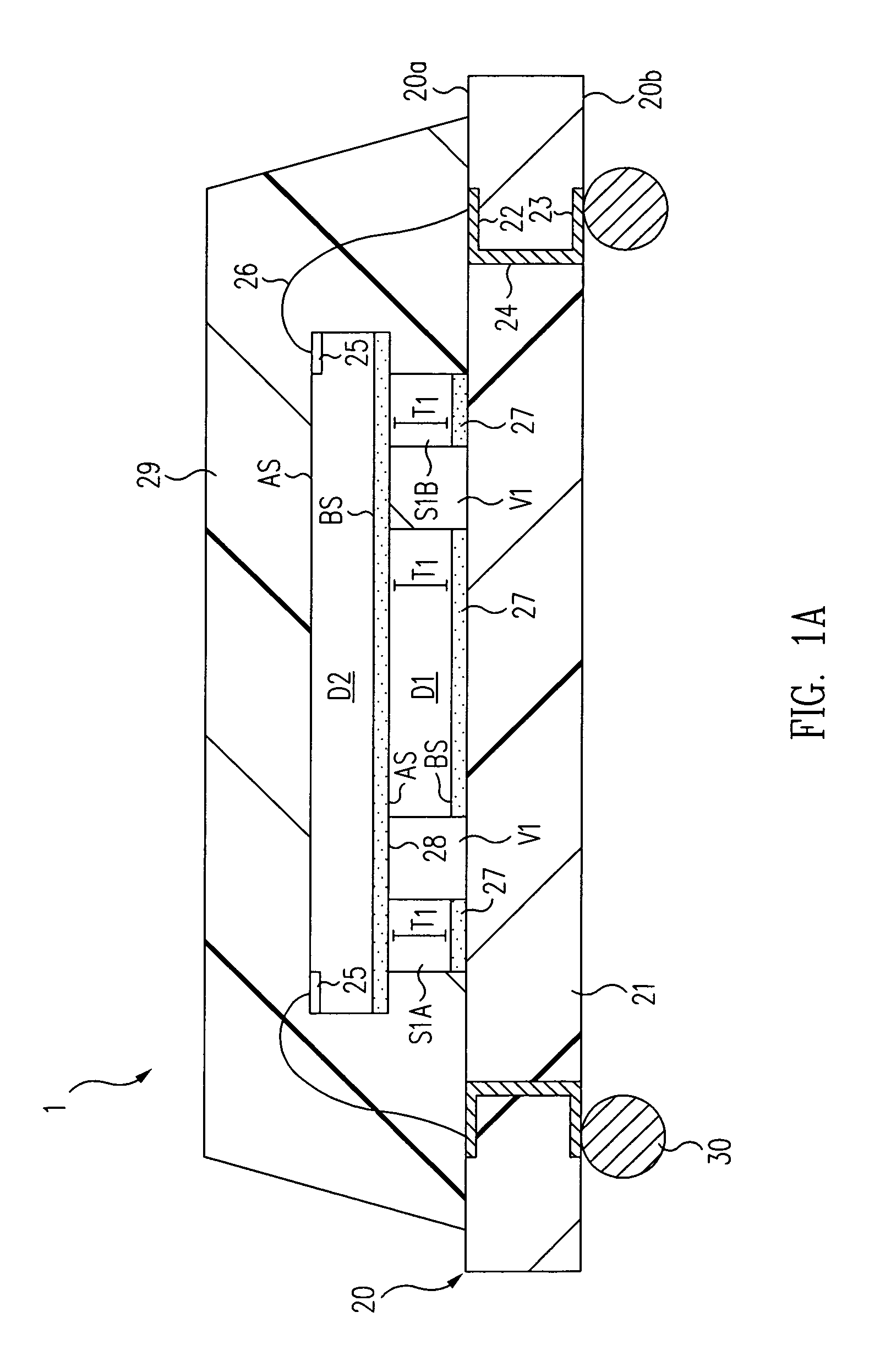Stacked semiconductor die assembly having at least one support
a technology of semiconductor dies and supports, applied in semiconductor devices, semiconductor/solid-state device details, electrical devices, etc., can solve problems such as significant overlap and exceed conventional tolerances, and achieve the effects of exceeding conventional tolerances, saving time and cost, and increasing stack siz
- Summary
- Abstract
- Description
- Claims
- Application Information
AI Technical Summary
Benefits of technology
Problems solved by technology
Method used
Image
Examples
first embodiment
[0041]FIGS. 1A and 1B illustrate a semiconductor package 1 in accordance with the present invention. The views of FIGS. 1A and 1B are at 90 degree angles to each other. FIG. 1A is taken along line 1A—1A of FIG. 3B, and the cross-sectional side view of FIG. 1B is taken along line 1B—1B of FIG. 3B.
[0042]Semiconductor package 1 includes two semiconductor dies, labeled D1 and D2, stacked one on top of the other and coupled together by an adhesive layer 28. The upper semiconductor die D2 is supported by underlying semiconductor die D1 and two underlying supports, labeled S1A and S1B. The number “1” in the labels D1 and S1A, S1B indicates that these structures are at a first level of a semiconductor die stack relative to the substrate. The number “2” in the label D2 indicates that the structure is in the second layer of the stack relative to the substrate. The letters “A” and “B” in the labels S1A and S1B distinguish between two similar structures in the same level of the stack. We will u...
second embodiment
[0072]FIGS. 4A and 4B are cross-sectional side views of a semiconductor package 2 within the present invention. FIGS. 5A–5D are simplified top plan views of semiconductor package 2. The cross-sectional view of FIG. 4A is taken along line 4A—4A of FIG. 5D, and the cross-sectional view of FIG. 4B is taken along line 4B—4B of FIG. 5D, which is 90 degrees from line 4A—4A.
[0073]Semiconductor package 2 includes a stack of four same-size semiconductor dies D1, D2, D3, and D4. Many aspects of semiconductor package 2 match aspects of semiconductor package 1, such as the form of substrate 20, bond wires 26, encapsulant 29, and solder balls 30. In addition, the arrangement and stacking of the lowest two semiconductor dies D1 and D2 and supports S1A, S1B of semiconductor die 2 of FIGS. 4A, 4B, 5A, and 5B is the same as the arrangement and stacking of semiconductor dies D1 and D2 and supports S1A, S1B of semiconductor package 1 of FIGS. 1A, 1B, 3A, and 3B. Accordingly, redundant discussion may b...
third embodiment
[0087]FIGS. 6A and 6B are cross-sectional side views of a semiconductor package 3 within the present invention. FIGS. 7A–7D are simplified top plan views of semiconductor package 3. The cross-sectional view of FIG. 6A is taken along line 6A—6A of FIG. 7D, and the cross-sectional view of FIG. 6B is taken along line 6B—6B of FIG. 7D, 90 degrees from line 6A—6A. Many aspects of semiconductor package 3 are the same as in semiconductor packages 1 and 2, and hence our discussion will focus on differences between the semiconductor packages and will largely omit redundant discussion.
[0088]Semiconductor package 3 includes a stack of four semiconductor dies D1, D2, D3, and D4. Unlike the die stacks of semiconductor packages 1 and 2, however, each successive semiconductor die DN (where “N” is the stack level) above the lowermost semiconductor die D1 is supported by the immediately underlying die D(N−1)and only one immediately underlying support S(N-1), whereas in semiconductor packages 1 and 2...
PUM
 Login to View More
Login to View More Abstract
Description
Claims
Application Information
 Login to View More
Login to View More - R&D
- Intellectual Property
- Life Sciences
- Materials
- Tech Scout
- Unparalleled Data Quality
- Higher Quality Content
- 60% Fewer Hallucinations
Browse by: Latest US Patents, China's latest patents, Technical Efficacy Thesaurus, Application Domain, Technology Topic, Popular Technical Reports.
© 2025 PatSnap. All rights reserved.Legal|Privacy policy|Modern Slavery Act Transparency Statement|Sitemap|About US| Contact US: help@patsnap.com



